Retail development thoughts or leveraging big box development for neighborhood retail. Can it be done?
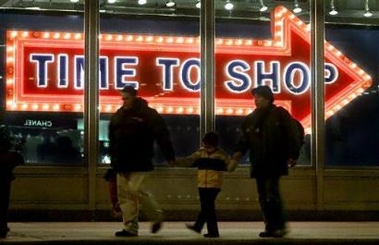 Pedestrians walk past a store window display along State Street on Monday, Nov. 28, 2005, in Chicago. (AP Photo/Jeff Roberson)
Pedestrians walk past a store window display along State Street on Monday, Nov. 28, 2005, in Chicago. (AP Photo/Jeff Roberson)Based on an email thread on the columbia_heights e-list:
William Jordan writes/1:
DC USA et al will bring the spill over foot traffic that these corridors need as well the anchor funding needed for a BID like structure to help keep areas clean and safe. This is especially true for non-liquor selling retail. The biggest challenge to these businesses is the cost of real estate caused by competing with condo development. Zoning policies that require ground floor retail in these areas may work for preserving affordable space for retailers. On the other hand, DC USA will be a harm to smaller business if corridors are left stagnent until DC USA opens. The work in these areas much occur now so that they are on solid footing before DC USA is fully operational.
My response:
The likelihood of spillover customer traffic is low, because people aren't going to shop in marginal commercial districts, especially the demographic type likely to be attracted to the big box stores in DC USA. This is reality and it may as well be understood now. (It's not true that if it's there, people will come--they have to have good reasons, and it's the flip side of the Law of Retail Gravitation. See this blog entry for more about that.) )
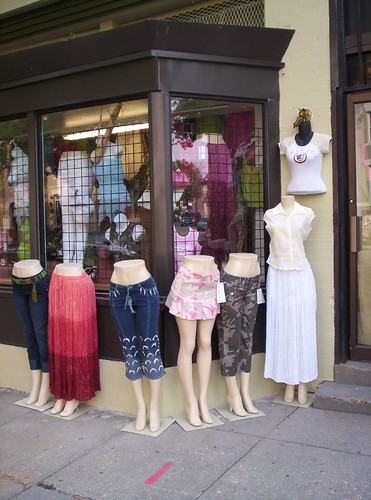 Franklin's Women's Clothing, 3300 block 11th St. NW, Photo taken July 2005. (Note: I like the way they merchandise here. It's better than a lot of places, but a couple stores aren't enough to attract significant patronage from people comfortable with Target and Bed, Bath and Beyond, etc.)
Franklin's Women's Clothing, 3300 block 11th St. NW, Photo taken July 2005. (Note: I like the way they merchandise here. It's better than a lot of places, but a couple stores aren't enough to attract significant patronage from people comfortable with Target and Bed, Bath and Beyond, etc.)However, the point about a BID and capturing funds to lead rehabilitation of the neighborhood commercial districts (NCD) and independent retail is EXCELLENT. This recognizes what the big boxes can provide--money and potentially traffic--that can be used to improve the "offer" of the NCDs.
This needs to be set up now............................
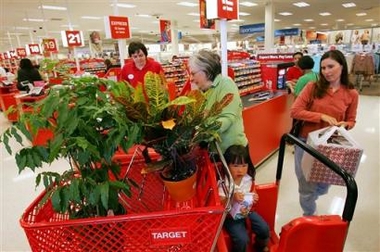 Tess Sullivan, middle, Hannah Tenney, 3, sittting, and Hannah's mother Sheila Tenney, right, purchase plants and other items with the help of Target employee George Hanna, left,at the Target store in Daly City, Calif. on Wednesday, Aug. 10, 2005. (AP Photo/Marcio Jose Sanchez)
Tess Sullivan, middle, Hannah Tenney, 3, sittting, and Hannah's mother Sheila Tenney, right, purchase plants and other items with the help of Target employee George Hanna, left,at the Target store in Daly City, Calif. on Wednesday, Aug. 10, 2005. (AP Photo/Marcio Jose Sanchez) William also writes:
As an aside, my issue with the Urban Disney-ist is that they tend to want to use a heavy hand in having our corridors change overnight, instead of supporting the corridor and having the market work. They tend to want the government to come in with heavy regulatory burdens and enforcement. Which is death is small business. Our regulory regime is already over burdensome and ineffecient giving it more power is fool hardy. Secondly, the tendency of Urban Disney-ist to focus on wanting to serve only one segment of our market.
I agree that "the city" doesn't have a very good feel for how to make small retail work and the regulatory regime is especially burdensome and expensive--chains have the infrastructure and patient capital to deal with this, independent businesses don't.
But don't be so quick to fully embrace the market. It's not "urban disney" that leads the development towards a particular kind of demographic (high income, etc.) it's in fact the market where the dictates of capital are such that you want to make the most money for the least investment and the least amount of problems. That's just the way it is. (E.g., it's why it's very hard to attract retail to distressed commercial districts, such as Historic Anacostia. Businesses aren't interested in being pioneers and dealing with all the b.s. that comes with being in such trying areas.)
Infrastructure rehabilitation in and of itself won't improve the offer of NCDs, you also need enlightened property owners, able business proprietors, a guiding force to lead change, and damn good demographics combining the neighborhood residential base with the potential for out-of-neighborhood patronage, since both are usually required to yield the numbers of patrons necessary to be successful.
 In the middle of the street at 8th and E Streets SE (Barracks Row).
In the middle of the street at 8th and E Streets SE (Barracks Row).Barracks Row is a "good example" of this, but I don't think people who work for the City Government really understand all the different elements that make it "work somewhat"--it's not as successful as outsiders think, because there aren't enough residents to support all the opening businesses, and there isn't enough attraction for outsiders to come and spend money there, so as each new business opens, it tends to cannibalize from the others, as the overall "pie" of the consumer base isn't increasing at the same rate as the number of businesses.
(This is why I admonish local neighbors and neighborhood groups, including Barracks Row Main Street and ANC6B for being so adamantly against "entertainment" and fears that 8th Street SE will become "Adams-Morgan" and their automatic rejection of any proposals for entertainment, from music in bars, to something more high-falutin. If they don't expand the "offer," Barracks Row will stagnate, because there aren't enough residents in the area to support thriving restaurants, which is basically all that BR has to offer)
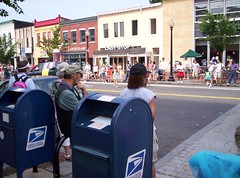 Spectators at the Barracks Row Fourth of July parade.
Spectators at the Barracks Row Fourth of July parade.Plus, people under-appreciate the value of the Capitol Hill BID kicking in almost to the day of the completion of the streetscape improvements. If that corridor looked as dirty throughout the day as it does at 8:30 a.m., people wouldn't be patronizing it despite the $8+ million in public infrastructure investments.
The Second Street initiative in Austin Texas and the Historic Los Angeles Retail initiative are examples where the respective jurisdictions are way more purposeful in terms of leading and assisting the development of independent retail businesses.
(A follow up email from me)
I forgot to mention one thing, that while "Barracks Row" might have been considered an emerging commercial district at the time of focused improvement programs, the residential neighborhood surrounding it would have been considered healthy with extremely favorable demographics. (But the area doesn't have the population density of CH.)
It's why the city's classification typology of neighborhoods as distressed, emerging, transitioning, and healthy needs to be considered in an even more micro fashion and applied to the residential part of the neighborhood separately from the commercial district.
Similarly, using this typology you can even do a block-by-block analysis of a neighborhood and/or its commercial districts, and code each block as D, E, T or H and then apply a set of differential policies and initiatives in order to "move each block forward."
And because I don't want to deal with any slavery cracks, note that improving a neighborhood from the standpoint of community economic development DOESN'T mean moving out lower performing demographics for higher performing demographics, it means creating and implementing the initiatives necessary to help lift all boats (as laid out in the Community Economic Development Handbook by Mihalio Temali).
Note that this is my expansion of the Rivlin work, as a way to apply it in a practical and useful fashion, and it's an idea and approach that I hope to develop in graduate school and beyond.
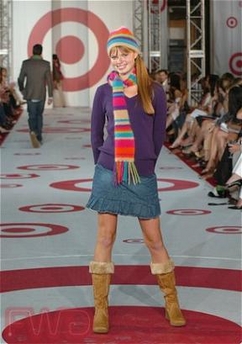 Model walks down the runway at the Target's Fall 2005 Vertical Fashion show in New York on Wednesday, July 27, 2005.(Fashion Wire Daily/Grant Lamos IV)
Model walks down the runway at the Target's Fall 2005 Vertical Fashion show in New York on Wednesday, July 27, 2005.(Fashion Wire Daily/Grant Lamos IV)Index Keywords: urban-revitalization



0 Comments:
Post a Comment
<< Home